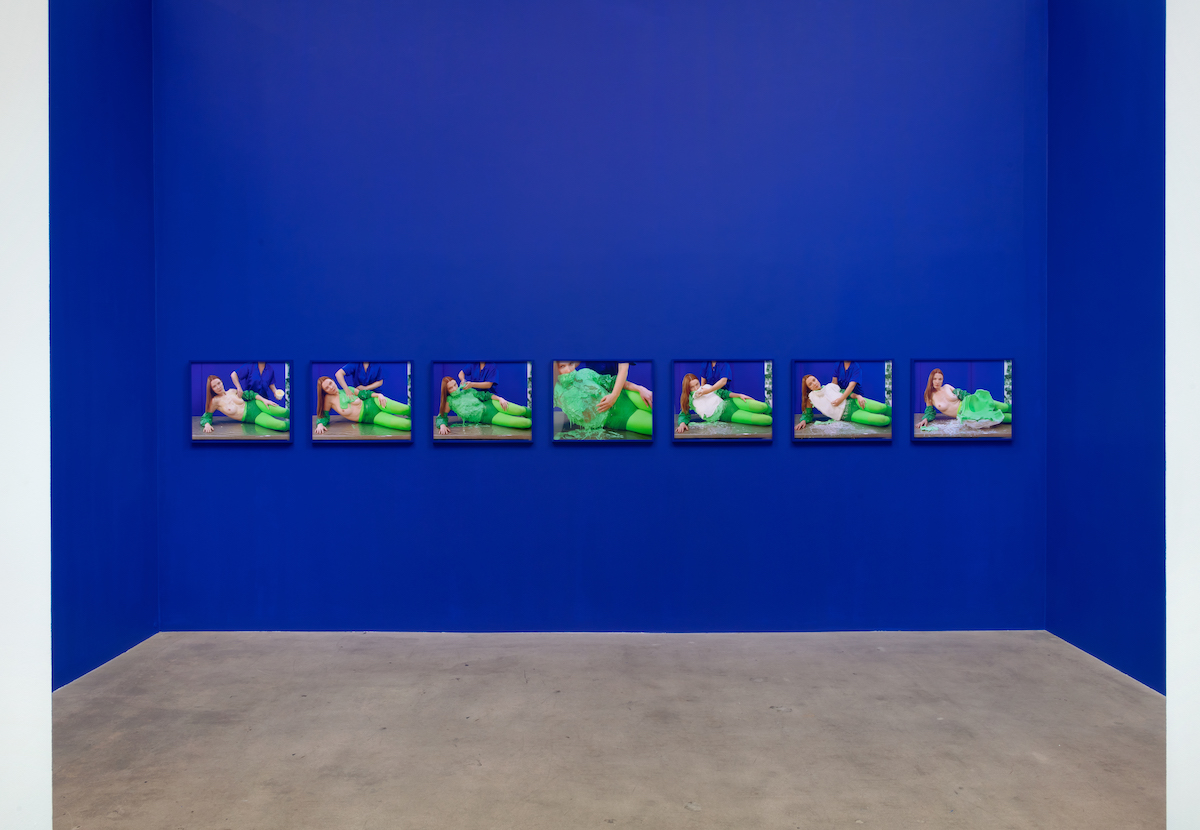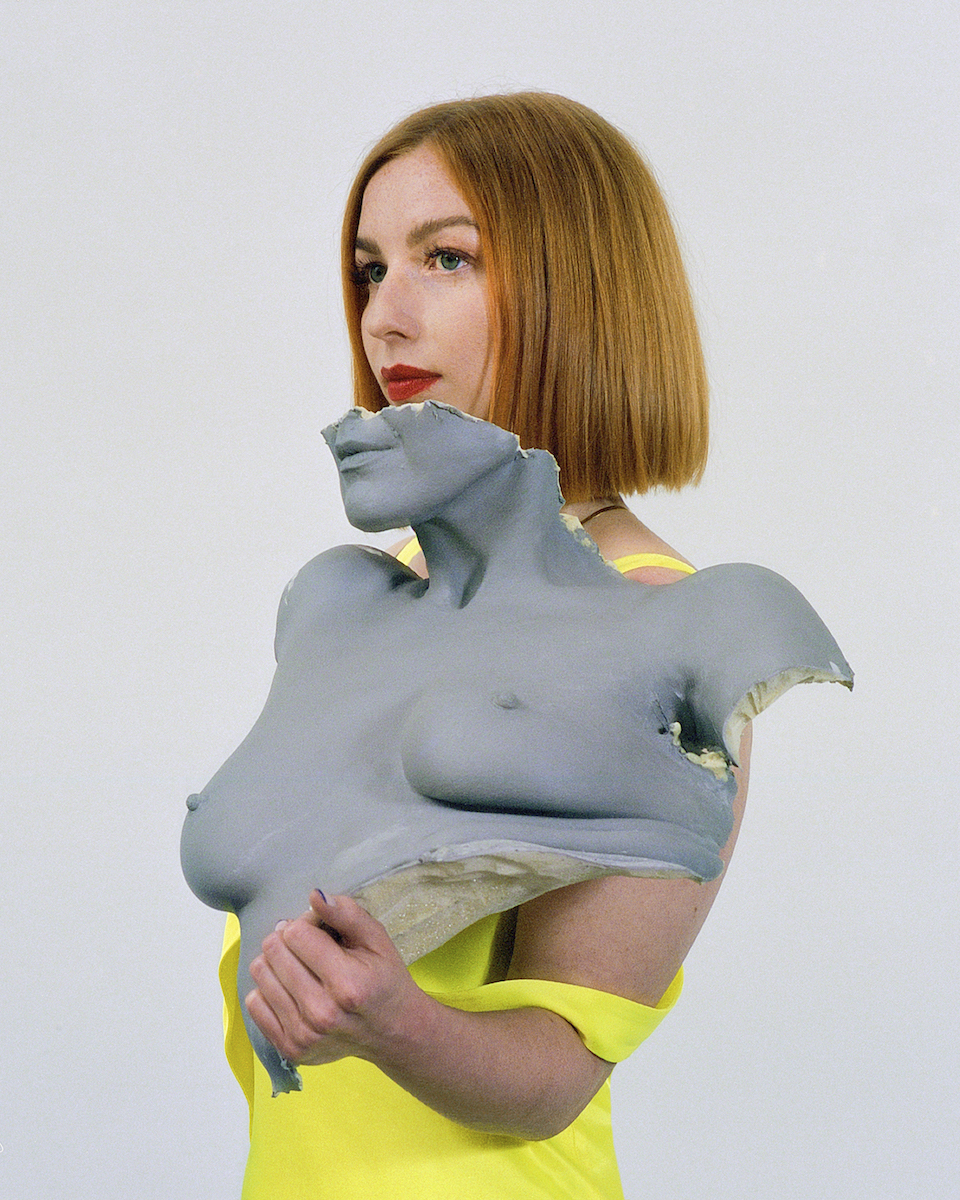Ilona Szwarc is a Polish-American artist based in Los Angeles. Her latest show, “Virgin Soap” at Diane Rosenstein Gallery, introduces sculpture alongside her photography, documenting herself casting a model’s torso in silicone and plaster. Other recent LA exhibitions include the group show “PAPA RAGAZZE!” curated by Olivia Neutron Bomb at Nicodim Gallery in 2020; and the solo show “Unsex Me Here” at Make Room in 2019. I met with Szwarc at her Boyle Heights studio to discuss her new body of work and the delicate balance her process strikes between documentation and fantasy, exposé and private revelation. What struck me most was Szwarc’s exuberance and eloquence, the attention to minutiae necessary to fabricate and inhabit hyper-real worlds beating with the terrifying pulse of an Eastern European fairy tale. As we chatted about breasts, doppelgängers and reclaiming the male gaze, it became clear in “Virgin Soap” Szwarc both measures with and holds the strings; her artist’s hands exuding the power of a puppeteer’s, the delicacy of a surgeon’s stitch, and—like The Fates at their wheel—weaves another world where a woman can regard and be regarded in all her animal mystery.
Julie Schulte: Talk to me about the establishing shot in a series like this.
Ilona Szwarc: I am interested in makeup tutorials and the aesthetics of instructional imagery. Those always begin with a “before” shot. The establishing photograph in “Virgin Soap” shows the model lying prone on the table—we feel the suspense, but nothing has happened yet. The perverse tutorial hasn’t begun.
I shot the series here in my LA studio and I knew from the get go that I wanted all the studio elements in the frame. I made the wallpaper, which I sourced from another work I had previously shown at Make Room LA. “Unsex Me Here” was entirely produced at a Palm Springs house that was decorated in Hollywood Regency style. The wallpaper pattern is borrowed from the couch upholstery. My intention was to juxtapose analog and digital photographic gestures. I wanted to make digital brushstrokes while sourcing the analog photograph to accentuate the tension between the two. Also, I really love connecting the different bodies of work, so I also decided to bring the glassware from the Palm Springs house. Although the distinct series look so different, there’s still some element of world building.
The way I staged my studio for the “Virgin Soap” shoot came from looking extensively at Matisse’s documentation of his studio. In the images of his studio, formally, there are predictable elements; there is always a pattern, always a room divider, always a still life, and always a naked woman. So, of course, it’s a bit cheeky on my part, but also my opportunity to take on this persona of the male, the heroic artist.

Installation view, “Virgin Soap” at Diane Rosenstein Gallery, photo by Robert Wedemeyer, courtesy Diane Rosenstein Gallery
This shade of green is so distinct. Could you speak more about how you decided on green?
“Virgin Soap” originated from me thinking about color. I made several photographs with a lot of green in the previous series and for this I knew I wanted to work with neon green. In photography and painting, green is a challenging choice; I wanted a chance to tackle it and to see where it took me. Then I brought in the blue. Of course, there are connotations of green screen and blue screen, so there is also that self-referential element to film, sfx and photography. Then, I just brought in all the different shades of greens and let them clash. The inclusion of the tennis balls was a formal choice. If I were a painter I would just be able to make a mark in this color and poof!—that’s all that the picture needed.
I read this is the first time you chose not to cast an American model and instead someone closer to your own heritage. Tell me about her and how you found her.
Talia Shvedova is a Russian immigrant living in Los Angeles. I met her through a friend who posed for me for another project. In the past I did casting calls for American women who look like me, but this time I wanted to depart from this idea and work with someone who shares much of my experience having moved from an adjacent culture and place in the world. She and I look so much alike to outsiders.

Installation view, “Virgin Soap” at Diane Rosenstein Gallery, photo by Robert Wedemeyer, courtesy Diane Rosenstein Gallery
Looking at these photographs there is a sense of progression and sequence that also gives the impression of erosion and escape. Talk to me about the order of these shots.
Although the show is installed in a nonlinear way when I was making the work, I had a narrative in mind. One gallery houses a sequence of seven photographs—almost a filmstrip—in which I hadn’t moved the camera and I am showing my process step by step.
“Virgin Soap” originated from my research in YouTube videos on how to use this type of silicone. I realized that in many of the videos middle-aged men would choose young models and the tutorial would be performed on their breasts—why not a hand or a foot?—but there’s an interesting thing happening in this exchange. The women are getting something too. There’s excitement and the tension of being uncomfortable; there’s also narcissism—the models get thrilled to see their breasts afterwards and have their youth saved for posterity. Another thing that popped up when I was viewing these videos was plastic surgeons performing the shoelace technique. Sometimes breast implants get misaligned and this technique is used to pop them back in place. Again, it seemed like—why are there so many of these videos? It’s an awkward thing and the lines are blurred in these dynamics. What kind of touch is it? Technical? Medical? Instructional? Erotic?
My first encounter with silicone was a pair of bra “enhancers” I tried out in high school. Describe working with this material.
My interest in working with silicone sculpture is because of how it relates to photography. It is a direct representation of reality, just like a photograph. It’s an image that can be reproduced, and it is produced in a two-step process—there is a negative (the mold) and a positive (the final sculpture). I anchor the sculpture in photography conceptually, and I also anchored it in the installation with a photograph that is placed on the platform. The more abstracted images in the series were taken during the process of making an edition of three identical sculptures that involved what’s called the mother mould.

Ilona Szwarc, Photo by Carlos Jaramillo
What a title! I love that name.
Me too! I considered it for this show actually. One side of the sculpture is hyper-realistic, pristine and perfect, and the other side is overflowing, perhaps one could think of something visceral and messy.
Let’s talk more about the title. Soap can cleanse, it can disinfect, but of course soap too recalls ablutions and spiritual purification. I read “Virgin Soap” is in dialogue with Charles Simic’s poem “Breasts.” While reading I landed on Simic’s metaphor that breasts “are the foam in which our hands are cleansed;” I thought, from his devotional position, of course he means men’s hands are cleansed by our bodies. There’s such a fine line between devotion and objectification. In your working with this doppelgänger, I see you reclaiming a process with your own body. It feels a feminist act—this opportunity for self-regard and self-revelation. Another line from Simic’s poem: “I insist that a girl stripped to the waist is the first and last miracle.” Can you speak to me about your own confrontation and experience with this “miracle”?
“Virgin Soap” tackles questions of objectification head on. It is all about me: I am in the photographs, I am pouring the silicone and making the sculpture. The person on whom I am performing those gestures is my proxy. I am also the beholder of the gaze so I can be as free as I want. Am I reliving some of my personal traumas and experiences? Sure. I feel like there are always two simultaneous stories about an artwork: one that is deeply personal, and another one that is more intellectual and derived from research. My experience since I was very young was about the feeling of the male gaze on me; a gaze that was intense and perhaps difficult to comprehend. I always wanted to make a piece about breasts as they have been a source of pleasure but also discomfort in my life depending on the circumstances. And I am thinking of the history of breasts in sculpture and painting too; only now—I am in charge.


